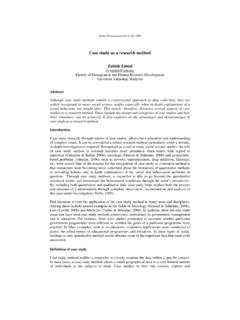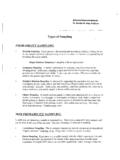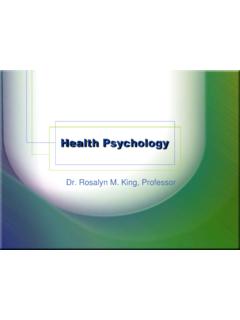Transcription of Case Study Methodology - psyking.net
1 1(14) case Study MethodologyRolf JohanssonArchitect SAR/MSA, Associate Institute of TechnologyInfrastructure / Urban Studies / Built Environment key note speech at the International Conference Methodologies in HousingResearch organised by the Royal Institute of Technology in cooperation with theInternational Association of People Environment Studies, Stockholm, 22 24 September (14)A case Study is expected to capture the complexity of a single case , and themethodology which enables this has developed within the social sciences. Suchmethodology is applied not only in the social sciences, such as psychology,sociology, anthropology, and economics, but also in practice-oriented fields suchas environmental studies, social work, education, and business studies.
2 As we cansee from the papers presented at this conference, case studies are very wellrepresented. At least a third of the papers discuss some aspect of case this presentation I will try to capture the essence of case Study Methodology :firstly, by discussing the notions of case Study and case ; secondly, by tracing itshistory; and finally, by making explicit its most characteristic notions of case Study and case There are different ideas about what a case Study is. If I try to find a commondenominator that case Study researchers (Yin 1994; Merriam 1994; Stake 1995,1998; Miles & Huberman 1994; Gillham 2001) might agree on, it would besomething along the following lines:The case Study should have a case which is the object of Study .
3 The case should be a complex functioning unit, be investigated in its natural context with a multitude of methods, and be , the case Study researchers mentioned above emphasise differentfeatures. Robert Stake (1998) points out that crucial to case Study research are notthe methods of investigation, but that the object of Study is a case : As a form ofresearch, case Study is defined by interest in individual cases, not by the methodsof inquiry used . Other researchers, such as Robert Yin (1994), place moreemphasis on the method and the techniques that constitute a case will use Stake s more inclusive definition: case Study is defined by interest inindividual cases .3(14)The concept of case Study introduces the first issue that I will discuss: how is thecase Study related to other research methods?
4 One major feature of case studymethodology is that different methods are combined with the purpose ofilluminating a case from different angles: to triangulate by combiningmethodologies. In a recently published book, Architectural Research Methods byLinda Groat and David Wang (2002), the relation between different researchstrategies in the field of architecture is illustrated as in figure 1. Groat & Wangexplain the relations between methodologies, as shown in their diagram, byarguing that those close to each other have more similarities than those that arefurther apart. Qualitative and interpretive research have in common a holisticapproach to the research subject, but with differing time research, on the other hand, shares with qualitative research a focuson naturally occurring circumstances, but is dependent on quantitative is also dependent on quantitative data, but with the requirementthat the researcher must be able to manipulate isolated variables.
5 Likewise,simulation requires control and manipulation. Logical argumentation whichincludes, for instance, space syntax analysis shares with simulation an emphasison abstraction. And interpretive-historical research is dependent on a constructedlogic of interpretation. This completes the Study /combined strategiesFigure 1. A conceptual framework for research methods. After Groat and Wang (2002), thediagram is simplified by the (14) case studies combine the other research strategies. In that respect the case studycould be said to be a meta-method. The purpose of Groat & Wang s positioning ofthe case Study in the middle of the diagram is not to argue that it is in any respectmore important than other methodologies.
6 I argue, though, that in practice-oriented fields of research, such as architecture and planning, the case Study has aspecial importance. The ability to act within professional practice is based onknowledge of a repertoire of cases. These cases are based either on personalexperience or are model cases established within the profession. case studiescontribute to the building of a professional repertoire. A designer s work is basedon comparisons between known cases from the repertoire and the actual designsituation (Sch n 1991).The emiprical world in full complexityA few variablesMany variables / qualitiesOne or a few units of analysis or casesMany units of analysis or casesCorrelational researchExperimentQuasi-experimentCase studyHistoryREDUCTIVEEXPERIMENTALEXPLICA TIVEF igure 2.
7 Three strategies to focus empirical research by reducing the units of analysis (cases), thenumber of variables (qualities), or both. The three strategies imply different methodologies. Casestudies are a form of explicative use another conceptual framework for research methodologies, focusing on thedifferent strategies that can be applied to reduce data in order to make theempirical world amenable to investigation. The number of variables (qualities)5(14)that are considered, or the number of cases (units of analysis), or both, can bereduced. (Figure 2).A case Study and, normally, history focus on one case , but simultaneously takeaccount of the context, and so encompass many variables and qualities.
8 I havelabelled this strategy explicative as opposed to experimental (one unit ofanalysis and a few isolated variables) and reductive (many units of analysis and afew variables) (Johansson 2002).The relation between case Study and history requires special attention. case studymethodology is developed within the social sciences. A prerequisite of thedevelopment of case Study Methodology was the focus on contemporary eventscharacteristic of the social sciences. Within research in the field of architecture andplanning, an artefact often serves as a focus of attention. When a physical artefactis the case (houses or housing areas, for instance, instead of an individual or asocial group) the gap between case Study and history tends to diminish.
9 An artefactis a carrier of its history. This is what the philosopher and archaeologist RobinGeorge Collingwood calls his first principle of a philosophy of history: that thepast which an historian studies is not a dead past, but a past which in some sense isstill living in the present (1939/1978:97). The context of design and the contextof use may be separated in time, but are often equally important to theunderstanding of the case of an artefact. In architectural research, when the case isa physical artefact, case studies often become more or less historical case studies(Johansson 2000a).I will now discuss the notion of case . What is a case ? The concept of case is notwell defined and remains a subject of debate.
10 The case may be a relativelybounded object or a process; it may be theoretical, empirical, or both (Ragin &Becker 1992). At a minimum, a case is a phenomenon specific to time and notion of case is complicated in another respect. The kind of case on whicha case Study focuses may change over time. It may change both in the hands of theresearcher and in the hands of the researcher s audiences (Ragin & Becker1992:8). It is characteristic of case Study Methodology that the boundaries, andoften even the focus of the case , change through the research process. Also, a casestudy focusing on a particular phenomenon might be read as an investigation of a6(14)different phenomenon. The classic Study Street Corner Society by William FootWhyte (1943/1993), for instance, can be read as it was originally intended by theauthor: as a multiple- case Study of boys gangs.




